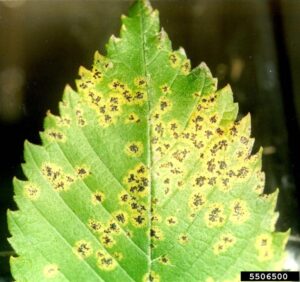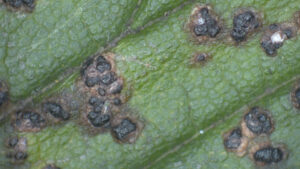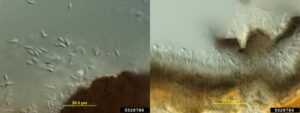We have received a few elm tree samples this year with a disease we do not often see, but which is relatively common: black spot of elm. This disease, also called elm anthracnose, is caused by the fungus Stegophora ulmea and can affect most species of elm with American elm varieties being more susceptible.
The fungus becomes active in the spring at temperatures of 45 deg F or above. It can release spores that will infect newly unfolding leaves leading to chlorotic leaf spots or blotches on the upper leaf surface. Black fungal fruiting bodies will develop within the affected tissue, making it seem like the leaves have been dotted with tar. These fungal structures are raised and will give the leaf a bumpy texture. As more spots develop and coalesce, they will create white areas of dead tissue that can eventually turn brown.
- Figure 1. Elm foliage with chlorotic spotting and black fungal structures caused by Stegophora ulmea. Photo Credit: Bruce Watt, University of Maine, Bugwood.org
- Figure 2. Elm foliage with large black fruiting bodies of Stegophora ulmea. Photo Credit: PPDL
The black fungal stromata can produce asexual spores (conidia) which can cause new infections during the growing season. Conidia are produced in a mucilage which becomes loose in humid conditions and can be spread by water splash (rain or irrigation). While leaf infections are the most commonly observed symptom, Stegophora can also infect leaf petioles and twigs. Premature leaf drop due to severe leaf spotting can occur, but significant defoliation may also develop when petioles are infected. Stem infections can lead to shoot blighting and small limb dieback.
Black spot is generally worse when the weather is cool and moist over an extended period of time. The fungus can reinfect the tree throughout the season during rainy. When the summer turns hot and dry, disease development will slow down and trees with twig blighting may show some recovery by pushing out new growth from dormant buds below affected shoots. Please note that twig blighting may look similar to flagging branches associated with Dutch elm disease (DED), so we recommend pruning off the branch and looking for internal vascular streaking to rule out DED.
- Figure 3. Microscopic image of fruiting bodies. Note how they are upraised from the leaf which will give the it a bumpy texture. Photo Credit: PPDL
- Figure 4. Microscopic image of asexual spores of Stegophora ulmea produced within the black fungal structures. Photo Credit: Bruce Watt, University of Maine, Bugwood.org
Fungicides are not normally recommended to manage this disease for mature trees in landscapes since it is impractical to get full coverage of the foliage and damage is not usually severe. However, preventative applications may be warranted in nursery settings when the disease is severe to protect new growth and slow down disease spread until drier weather occurs, especially where overhead irrigation is used. Raking up leaf litter and pruning out infected stems will remove inoculum for the following season and help prevent existing infections from spreading.
For more information on Dutch elm disease, please see the following link: https://purduelandscapereport.org//article/dutch-elm-disease/



